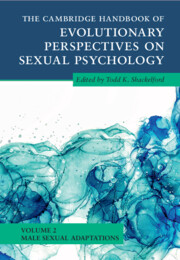Book contents
- The Cambridge Handbook of Evolutionary Perspectives on Sexual Psychology
- The Cambridge Handbook of Evolutionary Perspectives on Sexual Psychology
- Copyright page
- Contents
- Contributors
- Preface
- Part I Precopulatory Adaptations
- 1 Men’s Sexual Preferences
- 2 Men’s Extra-Pair Sexual Interest
- 3 Male Sexual Attraction Tactics
- 4 Men’s Intrasexual Competition
- 5 Competitiveness and Fatherhood as Overarching Domains of Female Choice in Human Evolution
- 6 Sexual Coercion and Rape
- 7 Mate Poaching by Men
- Part II Copulatory Adaptations
- Part III Postcopulatory Adaptations
- Index
- References
4 - Men’s Intrasexual Competition
from Part I - Precopulatory Adaptations
Published online by Cambridge University Press: 30 June 2022
- The Cambridge Handbook of Evolutionary Perspectives on Sexual Psychology
- The Cambridge Handbook of Evolutionary Perspectives on Sexual Psychology
- Copyright page
- Contents
- Contributors
- Preface
- Part I Precopulatory Adaptations
- 1 Men’s Sexual Preferences
- 2 Men’s Extra-Pair Sexual Interest
- 3 Male Sexual Attraction Tactics
- 4 Men’s Intrasexual Competition
- 5 Competitiveness and Fatherhood as Overarching Domains of Female Choice in Human Evolution
- 6 Sexual Coercion and Rape
- 7 Mate Poaching by Men
- Part II Copulatory Adaptations
- Part III Postcopulatory Adaptations
- Index
- References
Summary
Sex differences in obligatory parental investment and reproductive potential cause human females to desire high-quality men as partners. For men, this means that to achieve reproductive success, they must 1) combat other men to gain access to or retain mates, and to guard the resources women need for reproduction and child care, and/or 2) attract women by displaying (sexual) ornamentations or direct provision of resources. These pressures have shaped men’s physiology, as well as mating-related and other behaviors, and result in intense male–male intrasexual competition. In this chapter, I provide an overview of men’s intrasexual competitiveness, first detailing several important concepts, before focusing on the major domains of these competitions. The research reviewed shows that physical formidability and social status are central to human male–male competition – although qualitatively different, these dimensions are intertwined, such that formidable men are more likely to excel in physical combat and competition, and as a result attain higher social status and, ultimately, increased reproductive success. Men use an array of tactics to compete with same-sex rivals, ranging from direct aggression and physical contests (e.g., in sports or fights) to (verbal) competitor derogation, and the conspicuous flaunting of possessions, leisure activities, and helping behaviors. Finally, yet importantly, research on the context-dependent fluctuations in men’s testosterone levels sheds light on the underlying processes of male intrasexual competition. Specifically, increases in testosterone are observed both in preparation for and as a result of male–male competitions, and a sharp decline in testosterone after entering in a long-term romantic relationship or during fatherhood suggest a down-regulation of these competitive tendencies.
Keywords
- Type
- Chapter
- Information
- Publisher: Cambridge University PressPrint publication year: 2022



